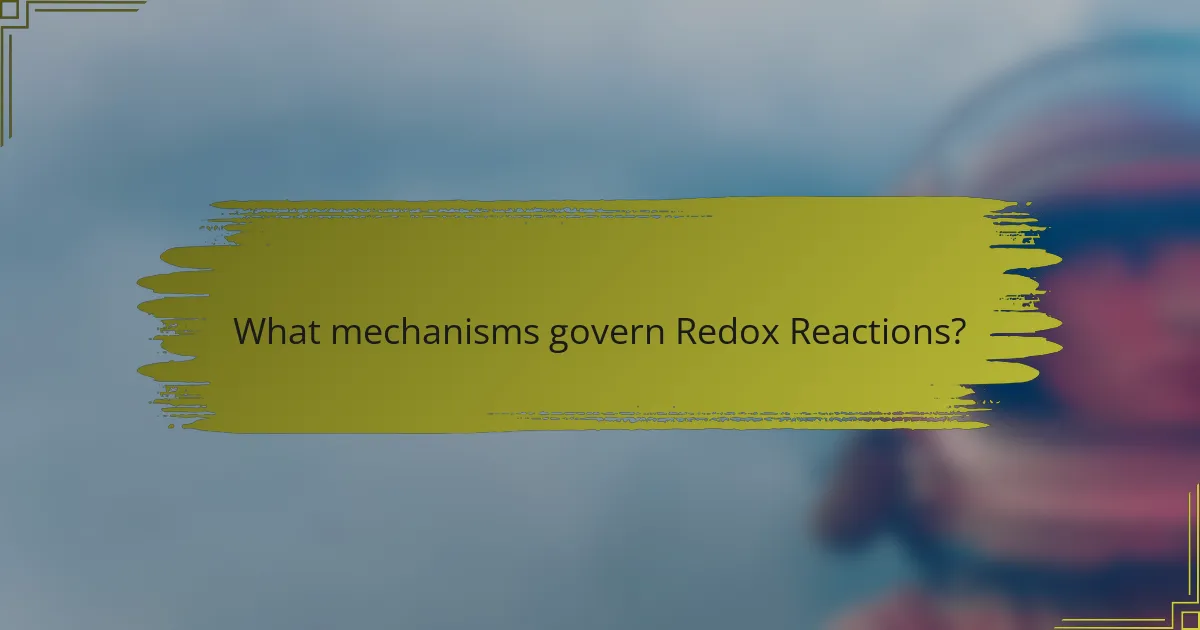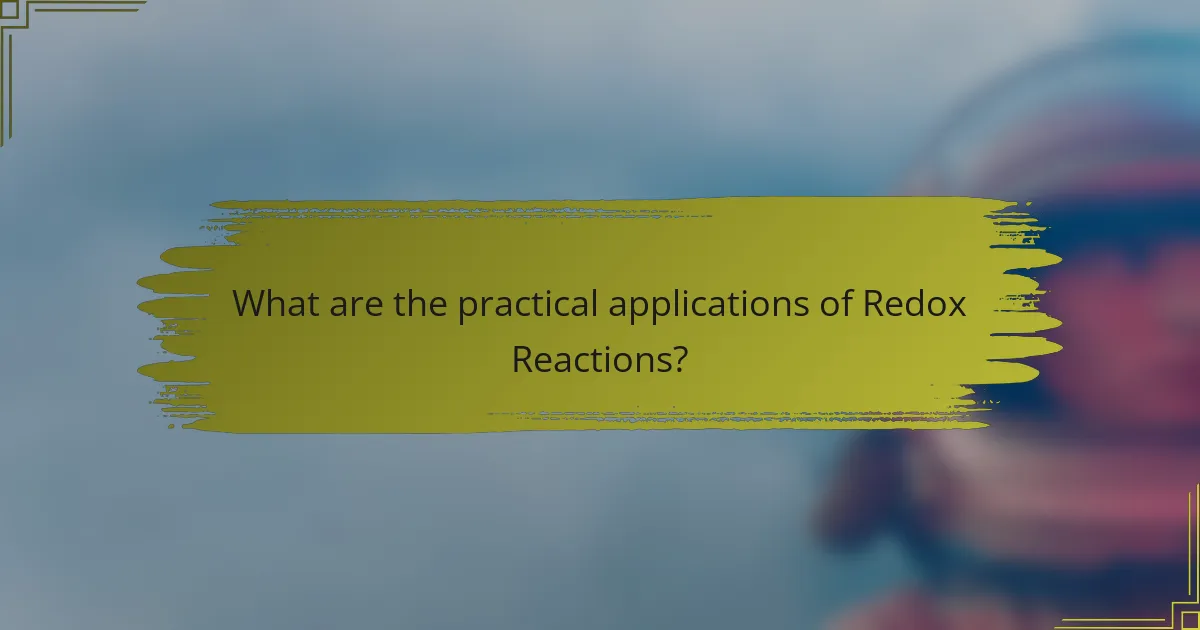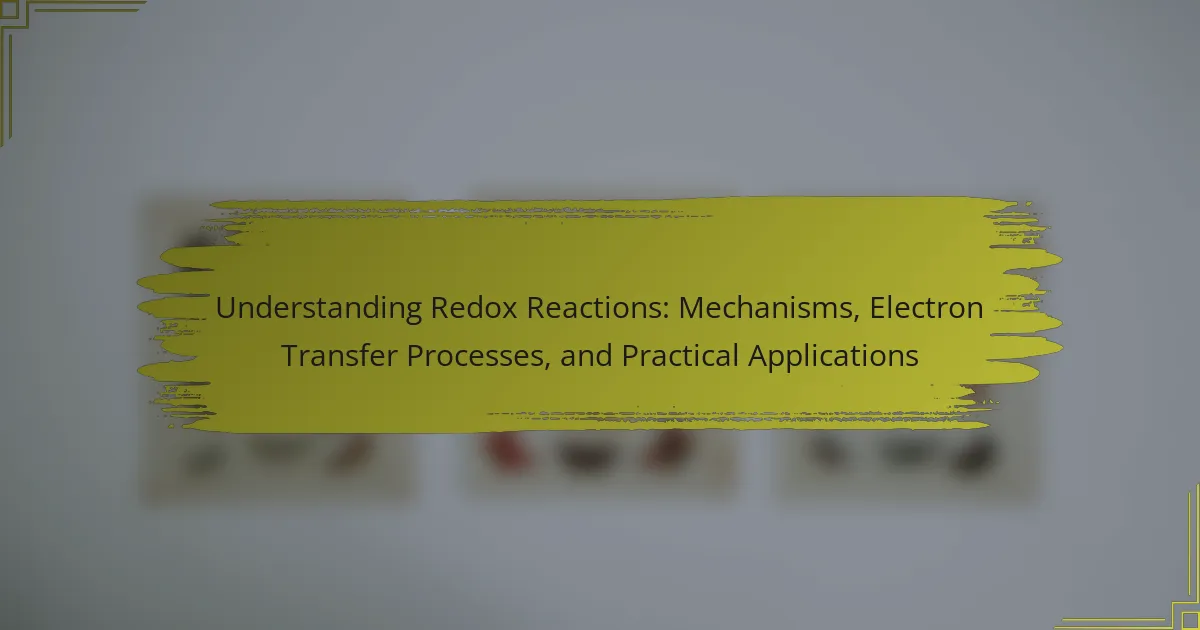
What are Redox Reactions?
Redox reactions are chemical processes involving the transfer of electrons between two substances. In these reactions, one substance is oxidized, losing electrons, while another is reduced, gaining electrons. This electron transfer results in changes in oxidation states of the involved substances. For example, in the reaction between hydrogen and oxygen to form water, hydrogen is oxidized and oxygen is reduced. Redox reactions are fundamental in various biological and industrial processes, including cellular respiration and electrochemical cells. They are characterized by oxidation numbers that change during the reaction, confirming the transfer of electrons.
How do Redox Reactions differ from other chemical reactions?
Redox reactions differ from other chemical reactions primarily through the transfer of electrons. In redox reactions, one species is oxidized, losing electrons, while another is reduced, gaining electrons. This electron transfer is fundamental to the process. In contrast, other chemical reactions may involve bond formation or breaking without electron transfer.
For example, in a simple acid-base reaction, protons (H+) are exchanged without any change in oxidation states. Redox reactions are characterized by changes in oxidation numbers, which are not present in non-redox reactions.
Furthermore, redox reactions are crucial in biological systems, such as cellular respiration. This process relies on electron transport chains, highlighting the importance of redox reactions in energy production. Overall, the defining feature of redox reactions is their unique mechanism involving electron transfer, setting them apart from other types of chemical reactions.
What are the key components of Redox Reactions?
Redox reactions involve two key components: oxidation and reduction. Oxidation is the loss of electrons from a substance. Reduction is the gain of electrons by a substance. These processes always occur simultaneously in a redox reaction. The substance that loses electrons is called the reducing agent. The substance that gains electrons is known as the oxidizing agent. Electrons transfer between these agents facilitates energy changes. This fundamental principle underlies many chemical reactions in nature and industry.
Why is understanding Redox Reactions important in chemistry?
Understanding redox reactions is crucial in chemistry because they are fundamental to various chemical processes. These reactions involve the transfer of electrons between substances, which is essential for energy production and storage. For example, redox reactions occur in batteries, where chemical energy is converted into electrical energy. Additionally, they play a significant role in biological systems, such as cellular respiration and photosynthesis. In industrial applications, redox reactions are used in metal extraction and wastewater treatment. The ability to predict and manipulate these reactions enhances our understanding of chemical behavior and reactivity. Overall, redox reactions are integral to both theoretical and practical aspects of chemistry.
What is the significance of electron transfer in Redox Reactions?
Electron transfer is crucial in redox reactions as it facilitates the transformation of energy and matter. In these reactions, one species loses electrons (oxidation) while another gains them (reduction). This transfer is fundamental to various biochemical processes, including cellular respiration and photosynthesis. For example, in cellular respiration, glucose is oxidized, and oxygen is reduced, resulting in ATP production. This highlights the significance of electron transfer in energy production within living organisms. Additionally, redox reactions are essential in industrial applications, such as batteries and corrosion processes. The continuous study of electron transfer mechanisms enhances our understanding of these vital processes.
How does electron transfer occur during Redox Reactions?
Electron transfer during redox reactions occurs through the oxidation and reduction processes. Oxidation involves the loss of electrons from a substance. Reduction involves the gain of electrons by another substance. One species donates electrons while another accepts them. This transfer creates an electric current in some cases. The two processes are interconnected and occur simultaneously. For example, in the reaction between zinc and copper sulfate, zinc oxidizes and copper reduces. This relationship is essential for energy transfer in biological systems.
What role do oxidizing and reducing agents play?
Oxidizing agents accept electrons during redox reactions, while reducing agents donate electrons. This electron transfer is fundamental in chemical reactions. Oxidizing agents facilitate oxidation by gaining electrons, thereby increasing their oxidation state. Common examples include oxygen, chlorine, and nitric acid. Reducing agents, on the other hand, enable reduction by losing electrons and decreasing their oxidation state. Examples of reducing agents include hydrogen, carbon, and metals like zinc. Understanding these roles is crucial in various applications, such as batteries, corrosion, and metabolic processes.
What are the different types of Redox Reactions?
There are four main types of redox reactions. These are combination reactions, decomposition reactions, displacement reactions, and combustion reactions.
Combination reactions occur when two or more reactants combine to form a single product. An example is when hydrogen gas combines with oxygen gas to form water.
Decomposition reactions involve a single compound breaking down into two or more products. An example is the electrolysis of water into hydrogen and oxygen gases.
Displacement reactions occur when an element displaces another in a compound. A common example is zinc displacing copper in copper sulfate solution.
Combustion reactions involve a substance reacting with oxygen to produce heat and light. An example is the combustion of methane in the presence of oxygen, producing carbon dioxide and water.
These classifications help in understanding the mechanisms and electron transfer processes involved in redox reactions.
What are the characteristics of combination reactions?
Combination reactions involve two or more reactants forming a single product. These reactions typically release energy, often in the form of heat or light. They can be represented by the general equation A + B → AB. Combination reactions usually occur between elements or simpler compounds. They are often exothermic, meaning they release energy. A common example is the formation of water from hydrogen and oxygen. In these reactions, the reactants are often in their elemental forms. This characteristic distinguishes combination reactions from other types of chemical reactions.
How do decomposition reactions exemplify Redox processes?
Decomposition reactions exemplify Redox processes by involving the breakdown of a compound into simpler substances. In these reactions, one or more reactants lose electrons while others gain them. For example, the decomposition of hydrogen peroxide (H2O2) into water (H2O) and oxygen (O2) demonstrates this. In this reaction, oxygen is reduced as it gains electrons, while hydrogen is oxidized as it loses electrons. This transfer of electrons is a hallmark of Redox processes. Thus, decomposition reactions serve as clear examples of how oxidation and reduction occur simultaneously.

What mechanisms govern Redox Reactions?
Redox reactions are governed by electron transfer mechanisms. These reactions involve oxidation, where an atom loses electrons, and reduction, where an atom gains electrons. The transfer of electrons occurs through various pathways, including direct transfer, coupled reactions, and mediators. In direct transfer, electrons move from the reducing agent to the oxidizing agent. Coupled reactions involve intermediates that facilitate electron transfer. Mediators, such as ions or molecules, can aid in the transfer process. The driving force behind these mechanisms is the difference in Electrode Potential. This potential reflects the tendency of a species to gain or lose electrons, influencing the reaction direction. Additionally, environmental factors like pH and temperature can affect redox reactions. These mechanisms are fundamental in processes like respiration and photosynthesis.
How do reaction conditions affect Redox mechanisms?
Reaction conditions significantly influence Redox mechanisms. Factors such as temperature, pH, and concentration affect electron transfer rates. Higher temperatures generally increase reaction rates due to enhanced molecular motion. Variations in pH can alter the oxidation state of reactants, impacting their reactivity. Concentration changes affect the availability of reactants, influencing the overall reaction kinetics. Additionally, the presence of catalysts can facilitate or hinder electron transfer processes. These conditions can shift the equilibrium of Redox reactions, leading to different products. For example, in acidic conditions, certain metals can be more easily oxidized. Therefore, manipulating reaction conditions is crucial for optimizing Redox reactions in practical applications.
What is the role of temperature in Redox Reactions?
Temperature influences the rate and equilibrium of redox reactions. Higher temperatures generally increase reaction rates due to enhanced molecular movement. Increased kinetic energy leads to more frequent and effective collisions among reactants. This can accelerate electron transfer processes, which are central to redox reactions. Additionally, temperature can affect the solubility of reactants and products, impacting the overall reaction dynamics. For example, in electrochemical cells, temperature changes can alter cell voltage and efficiency. Studies show that temperature variations can significantly affect the kinetics of redox reactions, demonstrating its critical role in these processes.
How does pH influence the mechanisms of Redox Reactions?
pH influences the mechanisms of redox reactions by affecting the availability of protons and the stability of reactants. In acidic conditions, higher concentrations of protons can enhance the reduction potential of certain species. This can lead to faster electron transfer rates in redox processes. Conversely, in alkaline conditions, the depletion of protons can hinder reduction reactions. The Nernst equation illustrates how pH changes can shift the equilibrium of redox reactions. For example, a decrease in pH typically increases the reduction potential of a half-reaction. This relationship is critical in biological systems, such as cellular respiration, where pH variations can significantly impact metabolic pathways.
What are the steps involved in a typical Redox Reaction mechanism?
A typical redox reaction mechanism involves several key steps. First, the oxidation and reduction processes occur simultaneously. In oxidation, an atom or molecule loses electrons, increasing its oxidation state. Meanwhile, in reduction, another atom or molecule gains those electrons, decreasing its oxidation state. The transfer of electrons is facilitated by an oxidizing agent and a reducing agent. The oxidizing agent undergoes reduction, while the reducing agent undergoes oxidation. This electron transfer can occur through direct contact or via electron carriers. The overall reaction is balanced to ensure that the number of electrons lost equals the number of electrons gained. Each step in the mechanism is crucial for maintaining charge balance and conserving mass.
What is the process of electron transfer in detail?
Electron transfer is a fundamental process in redox reactions. It involves the movement of electrons from one atom or molecule to another. This transfer can occur through various mechanisms, including direct transfer, tunneling, or via mediators.
In a redox reaction, the substance losing electrons is oxidized, while the substance gaining electrons is reduced. The electron donor and acceptor are often involved in a chemical bond rearrangement. The driving force for electron transfer is typically the difference in electronegativity between the donor and acceptor.
For example, in cellular respiration, glucose is oxidized, and oxygen is reduced. This process releases energy, which is harnessed by the cell. The electron transport chain in mitochondria exemplifies a series of electron transfers that create a proton gradient, ultimately producing ATP.
Overall, electron transfer is crucial in various biological and chemical processes, facilitating energy production and storage.
How do intermediates form during Redox Reactions?
Intermediates form during redox reactions through transient species that arise during electron transfer processes. These intermediates are often formed when reactants undergo partial oxidation or reduction. In many cases, a reactant donates an electron, creating a positively charged intermediate. Conversely, when a reactant accepts an electron, a negatively charged intermediate can form.
These intermediates are typically unstable and exist only for a short duration. They can lead to various products depending on the subsequent reactions they undergo. For example, in the oxidation of alcohols, an alkoxy radical may form as an intermediate before further oxidation to a carbonyl compound.
The presence of intermediates is crucial in determining the pathway and rate of the overall reaction. Studies have shown that intermediates can be detected using techniques like spectroscopy, confirming their formation during redox reactions.

What are the practical applications of Redox Reactions?
Redox reactions have numerous practical applications across various fields. They are fundamental in electrochemistry, specifically in batteries and fuel cells. For instance, lithium-ion batteries utilize redox reactions to store and release energy efficiently. In industrial processes, redox reactions are vital for metal extraction, such as the reduction of ores to obtain metals like copper and aluminum. Additionally, redox reactions play a crucial role in environmental chemistry, particularly in wastewater treatment, where they help in the removal of pollutants. In biological systems, redox reactions are essential for cellular respiration, enabling energy production in living organisms. Lastly, redox reactions are utilized in analytical chemistry for titrations to determine the concentration of substances. These applications illustrate the importance of redox reactions in both everyday technology and scientific research.
How are Redox Reactions utilized in energy production?
Redox reactions are fundamental to energy production in biological and chemical systems. They involve the transfer of electrons between substances, leading to energy release or storage. In cellular respiration, for example, glucose undergoes oxidation, releasing energy that is captured in the form of ATP. This process occurs in mitochondria, where electron transport chains facilitate electron movement, ultimately reducing oxygen to water.
In photosynthesis, redox reactions convert light energy into chemical energy. Water is oxidized, providing electrons that reduce carbon dioxide into glucose. Additionally, fuel cells utilize redox reactions to convert chemical energy from fuels directly into electrical energy.
The efficiency and effectiveness of these reactions are well-documented in scientific literature. For instance, the role of redox reactions in ATP synthesis is highlighted in the study “Mitochondrial Bioenergetics” by Brand and Nicholls. This demonstrates the critical role of redox processes in energy production across various systems.
What is the role of Redox Reactions in batteries?
Redox reactions are fundamental to the operation of batteries. They involve the transfer of electrons between two substances. In a battery, one substance undergoes oxidation, losing electrons, while another undergoes reduction, gaining electrons. This electron flow generates electric current, which powers devices.
For instance, in a lithium-ion battery, lithium ions move from the anode to the cathode during discharge. The oxidation of lithium at the anode releases electrons. These electrons flow through an external circuit, providing energy. At the cathode, lithium ions are reduced, completing the circuit.
The efficiency of this process is crucial for battery performance. Understanding the redox reactions allows for the design of better batteries with higher capacity and longer life.
How do fuel cells employ Redox principles?
Fuel cells employ Redox principles by facilitating oxidation-reduction reactions to generate electrical energy. In a fuel cell, hydrogen acts as the fuel and undergoes oxidation at the anode, releasing electrons. These electrons flow through an external circuit, creating an electric current. Simultaneously, oxygen at the cathode undergoes reduction by accepting electrons. This process generates water as a byproduct. The overall reaction is a combination of these oxidation and reduction processes. Fuel cells efficiently convert chemical energy into electrical energy through these Redox reactions.
What industries benefit from Redox Reactions?
The industries that benefit from redox reactions include the chemical manufacturing, energy production, and environmental sectors. In chemical manufacturing, redox reactions are crucial for producing various chemicals and materials. The energy production industry utilizes redox reactions in batteries and fuel cells for energy storage and conversion. Environmental applications involve redox reactions for wastewater treatment and pollution control. These industries rely on redox processes to facilitate electron transfer, which is essential for their operations. For example, the production of hydrogen through water splitting involves redox reactions, contributing to clean energy solutions.
How is the pharmaceutical industry impacted by Redox processes?
Redox processes significantly impact the pharmaceutical industry by influencing drug development and efficacy. These reactions involve the transfer of electrons, which can affect the stability and reactivity of pharmaceutical compounds. For example, redox reactions can alter the pharmacokinetics of drugs, impacting their absorption, distribution, metabolism, and excretion. Additionally, redox processes play a critical role in the mechanism of action for many drugs, particularly those targeting oxidative stress-related diseases. Research indicates that antioxidants, which are often involved in redox reactions, can enhance the therapeutic effects of certain medications. This interplay between redox chemistry and pharmacology is crucial for developing new therapies and improving existing ones.
What is the significance of Redox Reactions in environmental science?
Redox reactions are significant in environmental science because they drive essential biogeochemical processes. These reactions involve the transfer of electrons between substances, affecting the oxidation states of elements. They play a crucial role in nutrient cycling, such as nitrogen and sulfur cycles. For instance, denitrification, a redox process, converts nitrates into nitrogen gas, thus regulating nitrogen levels in ecosystems. Additionally, redox reactions influence pollutant degradation, like the reduction of heavy metals in contaminated soils. They also impact energy flow in ecosystems, as seen in microbial respiration. Overall, understanding these reactions helps in managing environmental health and sustainability.
What best practices should be followed when studying Redox Reactions?
When studying redox reactions, it is essential to follow systematic best practices. First, clearly define oxidation and reduction processes. Understanding these concepts is fundamental to grasping redox reactions. Next, balance redox equations accurately. This ensures that the number of electrons lost equals the number gained. Use half-reaction methods for clarity and precision in balancing.
Additionally, familiarize yourself with oxidation states. Identifying changes in oxidation states aids in recognizing redox processes. Utilize visual aids, such as diagrams and flowcharts, to illustrate electron transfer. This enhances comprehension of the mechanisms involved.
Conduct experiments safely, using appropriate protective gear and equipment. Safety is paramount when handling reactive substances. Lastly, review current literature and research. Staying updated with recent findings enriches your understanding of redox reactions and their applications.
How can one effectively conduct experiments involving Redox Reactions?
To effectively conduct experiments involving redox reactions, one must follow a systematic approach. Begin by clearly defining the reactants and products involved in the reaction. Use appropriate laboratory equipment, such as beakers, pipettes, and voltmeters, to facilitate accurate measurements. Ensure that all materials are properly prepared and that safety protocols are followed, including the use of personal protective equipment.
Next, set up the experiment by mixing the reactants in a controlled environment. Monitor the reaction closely, observing any changes in color, temperature, or gas production. Record data meticulously at regular intervals to analyze the reaction’s progress.
Utilize techniques like titration or spectrophotometry to quantify the concentrations of reactants and products. This will provide insight into the reaction kinetics and the efficiency of electron transfer processes.
Finally, analyze the collected data to draw conclusions about the reaction mechanisms involved. Compare the results with theoretical expectations to validate the findings. This structured methodology ensures reliable and reproducible outcomes in redox reaction experiments.
What common challenges arise in Redox Reaction studies?
Common challenges in Redox Reaction studies include difficulty in accurately measuring electron transfer rates. Variability in reaction conditions can affect results significantly. Additionally, the complexity of reaction mechanisms often complicates analysis. The presence of multiple reactants can lead to competing reactions. Understanding the role of solvents and temperature is crucial but often overlooked. Experimental setups may introduce errors in data collection. Moreover, theoretical models may not always align with observed outcomes. These factors collectively hinder the reliability of Redox Reaction studies.
Redox reactions are fundamental chemical processes characterized by the transfer of electrons between substances, where one is oxidized and the other is reduced. This article explores the mechanisms governing redox reactions, including the roles of oxidizing and reducing agents, types of redox reactions, and the significance of electron transfer in various applications. It also highlights the practical implications of redox reactions in energy production, industrial processes, and environmental science, while addressing challenges in studying these reactions. Understanding these concepts is crucial for grasping their impact on both theoretical and practical aspects of chemistry.
